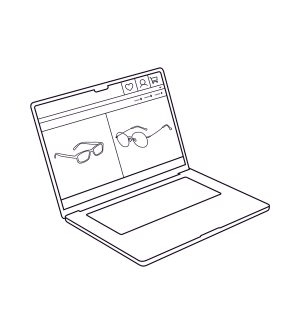ARTICLE
Vision Care Is Important yet Underutilized—Eyebot Can Help
Good vision and eye health are essential to overall health, and many fear blindness as one of the worst diseases that could ever happen to them. If this is the case, wouldn’t everyone do their best to protect their vision by seeing their eye doctor regularly?
LEARN MORE
People value their vision, but vision care services are underused
Good vision and eye health are essential to overall health, and many fear blindness as one of the worst diseases that could ever happen to them.(1) If this is the case, wouldn’t everyone do their best to protect their vision by seeing their eye doctor regularly?
The World Health Organization reports that more than 2.2 billion people around the world are living with near or distance vision impairment.(2) Over 1 billion of these people could have prevented their vision loss or have not yet received treatment for it.
Similarly in the US, 40% of blindness is preventable or treatable if diagnosed early.(3) Between 8-14 million Americans could improve their vision with proper screening and eyeglasses or contacts.(4,5)Many people do not receive regular vision care, including those who are most at risk for vision loss. About 40% of US adults are at high risk for vision loss due to age, diabetes or other eye problems, and only half of them had an eye exam in the last year.(6)
Why are people skipping eye exams?
As discussed in our article on common barriers to vision care, cost is one of the biggest factors preventing people from seeing the eye doctor, in addition to lack of insurance, time constraints, and transportation. Our article on the provider shortage describes the rising demand for eye doctors, which increases wait times for patients and makes scheduling a visit even more difficult.
According to nationwide studies, another significant reason that many Americans haven’t had an eye exam in the last two years is that they haven’t noticed any change or issues with their vision, as reported by 32-42% of US adults.(7,8) This way of thinking can be dangerous, as sight-threatening diseases like glaucoma and diabetic retinopathy may start to damage the eyes before causing any pain or other noticeable symptoms.(9) Having your vision and eye health checked regularly is critical for preventing vision loss and maintaining your best eyesight.
Easy access to vision care with Eyebot
The two leading causes of vision impairment and blindness around the world are refractive errors, such as nearsightedness, and cataracts.(2) Eyebot is a convenient solution for patients who want to check their vision and get an affordable eyeglass prescription.
Our 90-second vision test kiosks are easy to use, found in easily accessible locations in the community, and available at any time, with no appointment or insurance needed. Our 90-second vision screenings and tele-doctor services allow you to receive a new prescription within 24 hours, which can be used to purchase eyeglasses from any eyewear retailer.
A licensed eye doctor screens your results for over 30 eye-related diseases, including cataracts, and will refer you to a nearby eye doctor if any concerns are found.
Eyebot is also an easy way to monitor your vision throughout the year on your own schedule, without needing to travel to the doctor's office every time.
Eyebot’s vision screenings are not a replacement for comprehensive eye exams
While Eyebot vision screenings allow our tele-doctors to craft an eyeglass prescription and assess your risk for certain eye diseases, we recommend continued care with an eye doctor, especially for people 65 years or older or with known eye conditions.
The American Optometry Association and American Academy of Ophthalmology recommend a comprehensive eye exam with an eye doctor every 1-2 years for certain groups, depending on age and other risk factors.(9-10)
Our tele-doctors can identify over 30 diseases using Eyebot data, which is only a portion of over 270 eye-related and systemic conditions detectable from a comprehensive eye exam.(11)
Eyebot is constantly improving to screen for a wider range of diseases, and any signs of disease will always be referred for an in-person evaluation for an official diagnosis and treatment plan.
References:
1. Scott AW, Bressler NM, Ffolkes S, Wittenborn JS, Jorkasky J. Public attitudes about eye and vision health. JAMA Ophthalmol. 2016;134(10):1111-1118. doi:10.1001/jamaophthalmol.2016.2627
2. Blindness and vision impairment. World Health Organization. August 10, 2023. Accessed April 17, 2025. https://www.who.int/news-room/fact-sheets/detail/blindness-and-visual-impairment
3. Rowe S, MacLean CH, Shekelle PG. Preventing visual loss from chronic eye disease in primary care: scientific review. JAMA. 2004;291(12):1487-1495. doi:10.1001/jama.291.12.1487
4. Varma R, Vajaranant TS, Burkemper B, et al. Visual impairment and blindness in adults in the United States: demographic and geographic variations from 2015 to 2050. JAMA Ophthalmol. 2016;134(7):802-809. doi:10.1001/jamaophthalmol.2016.1284
5. Vitale S, Cotch MF, Sperduto RD. Prevalence of visual impairment in the United States. JAMA. 2006 May 10;295(18):2158-63. doi: 10.1001/jama.295.18.2158. PMID: 16684986.
6. Fast facts: 4 in 10 adults at high risk for vision loss. Centers for Disease Control and Prevention. May 15, 2024. Accessed April 17, 2025. https://www.cdc.gov/vision-health/data-research/vision-loss-facts/four-in-10-us-adults-hig h-risk-vision-loss.html
7. Ehrlich JR, Ndukwe T, Solway E, et al. Self-reported eye care use among US adults aged 50 to 80 years. JAMA Ophthalmol. 2019;137(9):1061-1066. doi:10.1001/jamaophthalmol.2019.1927
8. New survey on eye health finds most people say they know the importance of an annual eye exam, but - they actually don’t and they’re not getting one. News Release. Johnson & Johnson Vision. October 6, 2020. Accessed April 17, 2025. https://www.jjvision.com/press-release/new-survey-eye-health-finds-most-people-say-they-know-i mportance-annual-eye-exam-they
9. Elam AR, Tseng VL, Rodriguez TM, et al. Disparities in vision health and eye care. Ophthalmology. 2022;129(10):e89-e113. doi:10.1016/j.ophtha.2022.07.010
10. Comprehensive eye exams. American Optometric Association. Accessed April 17, 2025. https://www.aoa.org/healthy-eyes/caring-for-your-eyes/eye-exams?sso=y
11. Turbert D. Eye exam and vision testing basics. American Academy of Ophthalmology. February 14, 2024. Accessed April 17, 2025. https://www.aao.org/eye-health/tips-prevention/eye-exams-101
12. Systemic conditions with ocular and visual manifestations. American Optometric Association. December 2014. Accessed April 17, 2025. https://www.aoa.org/AOA/Documents/Healthy%20Eyes/Eye%20and%20vision%20conditions/Sys temic%20Conditions%20with%20Ocular%20and%20Visual%20Manifestations.pdf
